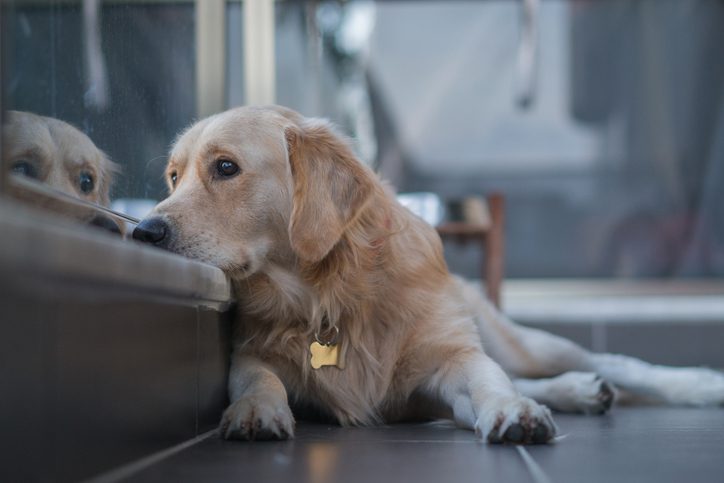Pet Separation Anxiety in Warrick County, IN: What You Need to Know
Some dogs and cats have difficulty when their pet parent leaves them alone for extended periods. Fortunately, there are many tactics you can use to help your pet become more confident and less stressed when you are away. It’s important to know the symptoms of your pet’s separation anxiety so you can help them adjust. Read the information below to learn more about pet separation anxiety in Warrick County, IN and what you need to know.

What is Separation Anxiety?
Pet separation anxiety is when your dog or cat feels anxious and upset about being left alone or without their pet parent. They may demonstrate destructive behaviors while they are left alone. The animal may also cry or pace in circles waiting for their human to come back. Often, fear of being left alone is a part of the equation.
It has even been compared to a human having a panic attack. Some experts have surmised that pet separation anxiety comes from past trauma associated with abandonment. It might be the loss of a family member or another pet in the home. If your pet was adopted or in a shelter, they could have trauma from that experience.
What Are the Symptoms of Separation Anxiety?
There are a lot of different symptoms of separation anxiety in pets. Many people believe that separation anxiety only occurs in dogs. However, it can also be an issue for cats. Animals have deep feelings, and they may not always express themselves appropriately. They are a lot like children in that they depend on their pet parents. We need to be sensitive to their emotions and find out how we can help.
The following are some of the usual symptoms of separation anxiety in pets:
Excessive Meowing or Barking
Every pet parent has been through it. As you are getting ready to leave the house, your fur baby looks at you with those puppy dog eyes and cries. Or, if they are a cat, they follow you around and “meow” at you. But you must be strong and do not make a big deal about leaving because this can trigger your pet to whine and cry.
Another scenario is that they start barking or meowing as soon as you walk out the door. Your pet misses you when you are not there, and you likely miss them too. However, you need to be able to leave the house without feeling bad or stressed out. Keeping them occupied when you are gone is a big part of what you can do to help them, which will be further explained in this article.
Engaging in Destructive Behavior
Despite your best efforts to protect your furniture and belongings, your pet may chew or claws at items in your house when you go out. Another way they demonstrate that they are stressed every time you leave is by to the bathroom in the house. Destructive behavior is a sure sign that your pet has separation anxiety.
Pacing, Circling, or Following You Around the House
Your dog or cat may follow you around as you get ready to go out of the house. They are just trying to tell you that they love being with you, or they may think that they can come with you. Your pet may also pace around your house or walk around in circles when you leave.
The pacing and circling come from the nervous energy that they are expending. It is a sign of anxiety, as well as obsessive-compulsive behavior. You need to set a precedent for your pet to let them know that leaving is no big deal and that you will return to them.
How Can I Help My Dog or Cat with Separation Anxiety?
You want to ensure that your pet is safe and content while away from the house. They need to be able to handle it when you are gone.
That is why the following tips that are listed below can make all the difference.
Make Sure Activities Occupy Them
It cannot be said enough that you need to make sure that your pets are occupied while you are away. Interactive dog and cat puzzles are great. Food toys are the best inventions for this purpose. They will learn to enjoy the ritual of getting a treat stuffed toy while you are out of the house. It will provide them with a sense of security. With cats, if all else fails, leave them with some good catnip!
Slowly Train Them to Be Alone in the House
When training your pet to be alone in the house, you need to do it slowly. It is best to avoid going out for several hours right away. A good way to start this is driving down the street and back for a short 5-minute trip. You can gradually work your way up from there. Also, never leave your dog for too long without someone to walk them. Your dog should not be left home alone for more than four hours. However, a trusted person to come to the house and walk them is a good idea.
Give Your Dog or Cat Exercise Before You Leave
Take your dog for a walk, or if you have time, take them to the dog park to play catch before you go away for hours. If you have a cat with separation anxiety, play games with them, like using a feather wand to get them active. Exercise is good for animals as it releases dopamine and helps them with stress. These are all great ways you can tire your pets out so that they may even sleep while you are away.
Don’t Make Leaving a Big Deal for Them
Our pets respond emotionally to us, and they may know when you are getting ready to leave. If you make a huge deal about it, so will they. If you are relaxed and calm when you leave, your pet will follow suit. When you come home, give them kisses and pets and tell them they are a good boy or girl for being so patient.
Contact Warrick Veterinary Clinic if Your Pet Has Separation Anxiety
Helping your pet with separation anxiety will take patience and hard work. However, helping your pet overcome their fear is worth the effort, especially when you are reunited with your sweet fur baby. If you have any additional questions or want to schedule an appointment, contact Warrick Veterinary Clinic in Warrick County, IN by calling (812) 897-4855. Our compassionate veterinarians are dedicated to providing excellent veterinary care for your pets and will treat them like family.
